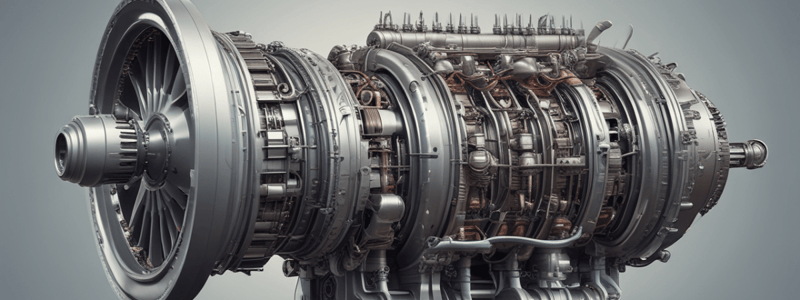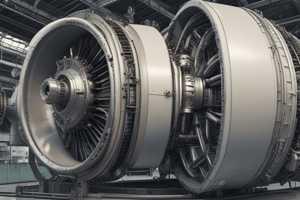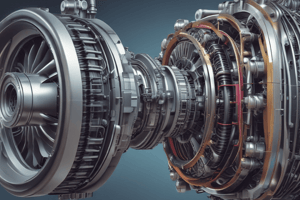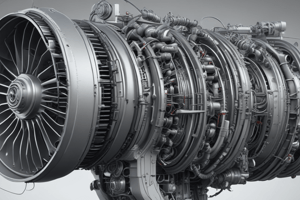Podcast
Questions and Answers
What is the formula for power?
What is the formula for power?
- Power = Work × Time
- Power = Work / Time
- Power = Force × Distance / Time (correct)
- Power = Force / Time
If an engine requires 500 foot-pounds of work per minute, how much power does it require?
If an engine requires 500 foot-pounds of work per minute, how much power does it require?
- 500 foot-pounds per minute (correct)
- 250 foot-pounds per minute
- 1000 foot-pounds per minute
- 5000 foot-pounds per minute
What is the unit of measurement for Power?
What is the unit of measurement for Power?
- Newtons per minute
- Foot-pounds per second
- Foot-pounds per minute (correct)
- Joules per minute
If a 2500-lb engine is to be hoisted a height of 9 ft in 2 min, how much power is required?
If a 2500-lb engine is to be hoisted a height of 9 ft in 2 min, how much power is required?
What is the formula for Work?
What is the formula for Work?
If the force required to hoist an engine is 2500-lbs, and the distance is 9 ft, what is the work done?
If the force required to hoist an engine is 2500-lbs, and the distance is 9 ft, what is the work done?
What is the formula for velocity?
What is the formula for velocity?
What is acceleration defined as in physics?
What is acceleration defined as in physics?
What is the SI unit for acceleration?
What is the SI unit for acceleration?
What is velocity in the context of a gas turbine engine?
What is velocity in the context of a gas turbine engine?
What is the difference between the velocity of the two aircraft in the diagram?
What is the difference between the velocity of the two aircraft in the diagram?
Why is velocity a vector quantity?
Why is velocity a vector quantity?
What is the main concept behind Newton's Third Law of motion?
What is the main concept behind Newton's Third Law of motion?
What is the result of accelerating a mass of air backwards in a jet engine?
What is the result of accelerating a mass of air backwards in a jet engine?
What is the main principle behind Bernoulli's Theorem?
What is the main principle behind Bernoulli's Theorem?
What is the purpose of a venturi in relation to Bernoulli's Theorem?
What is the purpose of a venturi in relation to Bernoulli's Theorem?
What happens to the pressure inside the balloon as it deflates, according to Newton's Third Law?
What happens to the pressure inside the balloon as it deflates, according to Newton's Third Law?
How do Newton's three laws of motion relate to each other?
How do Newton's three laws of motion relate to each other?
What is the primary function of the compressor in a turbojet engine?
What is the primary function of the compressor in a turbojet engine?
What is the main advantage of turbojet engines in high-altitude operations?
What is the main advantage of turbojet engines in high-altitude operations?
What is the purpose of the turbine wheels in a turbojet engine?
What is the purpose of the turbine wheels in a turbojet engine?
What is the main difference between turbojet and turbofan engines?
What is the main difference between turbojet and turbofan engines?
What is the primary purpose of the bypass feature in a turbofan engine?
What is the primary purpose of the bypass feature in a turbofan engine?
At what speed range is the turbojet or turbofan engine most widely used?
At what speed range is the turbojet or turbofan engine most widely used?
What percentage of thrust is produced by the fan in a high bypass fan engine?
What percentage of thrust is produced by the fan in a high bypass fan engine?
What is the characteristic fan ratio of an ultra-high bypass engine?
What is the characteristic fan ratio of an ultra-high bypass engine?
Which of the following engines is an example of an ultra-high bypass engine?
Which of the following engines is an example of an ultra-high bypass engine?
What is a characteristic of a ducted fan engine?
What is a characteristic of a ducted fan engine?
What is the advantage of the turbofan engine?
What is the advantage of the turbofan engine?
What is the bypass ratio of the P&W 1000G geared fan engine?
What is the bypass ratio of the P&W 1000G geared fan engine?
Study Notes
Power and Work
- Power formula: P = F × D / t, where P = Power in foot-pounds per minute, F = Force, D = Distance/Displacement in feet, t = Time in minutes
- Power can also be related to velocity: P = F × V, where V = Velocity
Velocity
- Velocity formula: V = D / t, where V = Velocity, D = Displacement, t = Time
- Velocity is a vector quantity
- Important in a gas turbine engine, particularly in controlling engine operating temperatures and resultant thrust
Acceleration
- Defined as a change in velocity with respect to time
- Typical units: feet per second per second (fps/s), miles per hour per second (mph/s), and meters per second squared (m/s²)
Newton's Third Law
- "For every action, there is an equal and opposite reaction"
- Illustrated through the example of a deflating balloon, where the air escaping the balloon creates an equal and opposite force that propels the balloon forward
- Applies to all forms of jet propulsion, including turbojet engines
Bernoulli's Theorem
- States that as air velocity increases, pressure decreases, and as velocity decreases, pressure increases
- Illustrated through the example of a venturi, where air velocity increases as it passes through a narrowing in a tube, resulting in decreased pressure
Turbojet Engine
- Uses the acceleration of airflow throughout the engine to produce thrust
- Well-suited for high-speed, high-altitude operations
- Basic operating principles:
- Air enters through an inlet duct and is compressed
- Fuel is added and ignited in the combustor section
- Heat generated by combustion causes compressed air to expand and flow towards the rear of the engine
- Air exits the engine at a much higher velocity than the incoming air, producing thrust
Turbofan Engine
- Developed for subsonic cruising speeds
- Has become the most popular power plant for commercial and business jets
- Greater propulsive power at higher subsonic cruising speeds
- Replaced the turbojet engine due to its higher efficiency
Turbofan/Bypass Engines
- Consists of a multi-bladed ducted propeller driven by a gas turbine
- Produces most of its thrust from the fan (up to 80%)
- Fitted to large commercial jets
Ultra-High Bypass Engine
- Has a fan ratio of 9:1 or greater
- Requires a larger fan diameter and a geared fan
- Examples: CFM LEAP, RR Trent 1000, P&W 1000G geared fan
- Produces up to 90% of its thrust from the fan
Studying That Suits You
Use AI to generate personalized quizzes and flashcards to suit your learning preferences.
Related Documents
Description
This quiz covers the formulae for power and work in the context of gas turbine engine, including the substitution of work formula into power formula.




